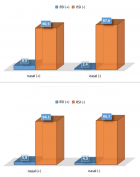Table of Contents
ACE2 and TMPRSS2 polymorphisms and the development of COVID-19: a review of the literature
Published on: 28th April, 2022
SARS-CoV-2 is a virus that has a positive-sense, single-stranded RNA genome that encodes 4 structural proteins, the main one being the S protein (Spike) responsible for mediating with ACE2 and TMPRSS2 for entry into the host cell. The study of single nucleotide polymorphisms (SNPs) of ACE2 and TMPRSS2 can elucidate their possible intervention in the action of the protein, its activity, and the gene expression of encoding these enzymes, which may increase susceptibility to viral infection. From this, literature searches were carried out until December 2021, listing 11,820 publications for literary analysis on the described genetic variations of these protein structures, as well as their relation and influence on the pathology. It was possible to conclude that there is a great influence exerted by genetic variability in ACE2 and TMPRSS2 increasing the ability of the virus to bind to the host cell and the development of COVID-19 with complications.
Geopolitical issues in health and biosecurity concerning gain-of-function research, emergence and re-emergence of infectious diseases
Published on: 4th March, 2022
There are global concerns in the dissemination and transmission dynamics of emerging and reemerging infectious diseases and the underlying features of gain-of-function research and geopolitics within and across borders. These concerns have become pertinent in the management of local and global health because the disease is perspicuously a geopolitical issue ostensibly linked to gain-of-function research where health diplomacy focuses on the present and future global emergence and re-emergence of infectious diseases, pandemics, and microbiome variants. These have generated vehement reactions with a propensity for extreme geopolitics and gain-of-function natural and anthropogenic activities. Geopolitical parameters and gain-of-function issues impact the social determinants of health and vice versa. The convening and convergence of countries for unprecedented epidemic or pandemic treaty settings or other formulations to confront emerging and reemerging infectious diseases will afford considerable opportunities concerning challenges in action, preparedness, and response. Provisions are pertinent for legal instruments, effective and efficient systems to curb future threats and outbreaks of infectious diseases.
Impact of the COVID-19 infection on the “benign” nature of the illness of Schönlein-Henoch
Published on: 11th January, 2022
OCLC Number/Unique Identifier: 9391761803
The incidence of COVID-19 in children has been variable. Although now the number of infected children worldwide, and in particular nationally, is small, they are not protected from the infection. Moreover, in the most severe cases septic shock, metabolic acidosis, irreversible bleeding, and coagulation dysfunction have been registered.In February 2021 a 17-year-old boy showed for examination with complaints of pain in the upper part of the abdomen, accompanied by involvement of the ankle joints, the appearance of a rash on the lower extremities with the characteristic of hemorrhagic vasculitis, and a positive test for COVID-19. The characteristics of the skin purpura, the abdominal pain, and the arthralgia led us to the diagnosis of Schönlein-Henoch purpura. The verification of past COVID-19 infection was done by the established high titer of specific IgG antibodies. The clinical evolution of the disease went beyond its generally accepted benign nature - the first manifestation of the illness had been followed by four more relapses, which necessitated new hospitalizations and a change in the therapeutic approach.COVID-19 infection is the cause of a more aggressive course of vasculitis.
Evaluation of the LumiraDx SARS-CoV-2 antigen assay for large-scale population testing in Senegal
Published on: 5th January, 2022
OCLC Number/Unique Identifier: 9391752258
Purpose: Real-time reverse-transcription polymerase chain reaction (RT-PCR)-based testing remains the gold standard for the diagnosis of the severe acute respiratory syndrome coronavirus 2 (SARS-CoV-2). Due to the high diagnosis demand of SARS-CoV-2 and the limited resources for RT-PCR testing, especially in Low-Income Countries (LICs), antigen-based methods are being considered as an option. The aim of this study was to assess the performance of LumiraDx SARS-CoV-2 antigen assay for large population screening compared to RT-PCR.Methods: This evaluation was conducted on 4146 participants including travelers and participants under household survey and vaccine evaluation studies before injection of the first dose. Oropharyngeal and nasopharyngeal swaps were collected from each participant into 2 mL of viral transport medium (VTM) and 400 μl of VTM were used to assess the performance of LumiraDx SARS-CoV-2 antigen assay, compared to RT-PCR. Results: The prevalence of SARS-CoV-2 of the cohort was 4.5% with RT-PCR and 4.1% with LumiraDx antigen test. Compared to the RT-PCR, the sensitivity and specificity of the LumiraDx antigen SARS-CoV-2 test were 82,7% [95% CI 74.1-89,7] and 99.9% [95% CI 99.6-99.9] respectively. Given the RT-PCR threshold cycle (Ct) range, the sensitivity was 92.1% [95% CI 84.6-96.3] when the Ct value was below or equal 33 cycles, and 38.1% [95% CI 18.9-61.3] when it was above 33 cycles. The inter-rater reliability showed a kappa coefficient of 0.88 when considering all the patients and 0.94 for Ct values below 33 cycles. Conclusion: Our data have shown that the LumiraDx platform can be considered for large-scale testing of SARS-CoV-2.

If you are already a member of our network and need to keep track of any developments regarding a question you have already submitted, click "take me to my Query."

















































































































































